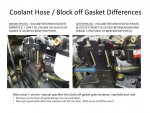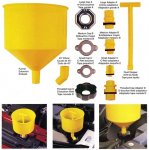Lou C
Supreme Mariner
- Joined
- Nov 10, 2002
- Messages
- 11,830
1) I'd want to find out more about why your engines are pushing enough coolant out of the H/E that it overflows the reserve tank. This should not be happening. In fact the only vehicle we had that did this, was our '98 Subaru Legacy Outback when it was about to blow the head gaskets. It did this twice, once at about 109,000 miles (fixed it then) and again at 186,000 miles (traded the vehicle).
2) In reference to the question about condensation inside the manifolds causing the water to be there, hard to say. I store my boat in the same kind of conditions, ie damp winter, temps range from well over freezing to freezing, its common to see water droplets all over the outside of the engine. However, out of curiosity I will remove the oil cap to see if there is condensation inside the valve cover (or underside of oil cap) and have never seen any. So I kind of doubt that water you saw is from condensation.
3) when you did the pressure test, you tested for 15+ min, I'd want to see a longer test (like when you test a gearcase) to see if the pressure drops over time.
4) I have never air tested manifolds but have done the acetone test on my Cobra one piece manifolds, before re-installing after checking them at regular intervals due to salt water use. You might try doing this, if they are still off the boat, since what you want to know is if liquid can pass through a crack, or casting flaw. Using liquid with lower surface tension than water, may be a more valid test. I propped my Cobra manifolds up and filled with them with acetone and let them sit several hours. No leaks believe it or not.
2) In reference to the question about condensation inside the manifolds causing the water to be there, hard to say. I store my boat in the same kind of conditions, ie damp winter, temps range from well over freezing to freezing, its common to see water droplets all over the outside of the engine. However, out of curiosity I will remove the oil cap to see if there is condensation inside the valve cover (or underside of oil cap) and have never seen any. So I kind of doubt that water you saw is from condensation.
3) when you did the pressure test, you tested for 15+ min, I'd want to see a longer test (like when you test a gearcase) to see if the pressure drops over time.
4) I have never air tested manifolds but have done the acetone test on my Cobra one piece manifolds, before re-installing after checking them at regular intervals due to salt water use. You might try doing this, if they are still off the boat, since what you want to know is if liquid can pass through a crack, or casting flaw. Using liquid with lower surface tension than water, may be a more valid test. I propped my Cobra manifolds up and filled with them with acetone and let them sit several hours. No leaks believe it or not.























